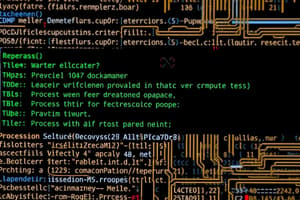Podcast
Questions and Answers
What is the primary function of memory management in an operating system?
What is the primary function of memory management in an operating system?
- Allocates and deallocates memory space (correct)
- Processes jobs in batches
- Handles user interface design
- Manages device communication
Which type of operating system allows multiple users to access the system simultaneously?
Which type of operating system allows multiple users to access the system simultaneously?
- Real-Time Operating System
- Embedded Operating System
- Time-Sharing Operating System (correct)
- Batch Operating System
Which of the following is NOT a function of an operating system?
Which of the following is NOT a function of an operating system?
- Process Management
- Data Backup Management (correct)
- File System Management
- Security and Access Control
What role do system calls play in an operating system?
What role do system calls play in an operating system?
Which component of an operating system is responsible for core resource management?
Which component of an operating system is responsible for core resource management?
What is a characteristic of real-time operating systems?
What is a characteristic of real-time operating systems?
Which performance metric measures the efficiency in using system resources?
Which performance metric measures the efficiency in using system resources?
What is a common trend in modern operating systems?
What is a common trend in modern operating systems?
Flashcards are hidden until you start studying
Study Notes
Definition
- An operating system (OS) is software that manages computer hardware and software resources.
- Provides common services for computer programs.
Functions
-
Process Management
- Handles processes in execution.
- Supports multitasking and process scheduling.
-
Memory Management
- Allocates and deallocates memory space as needed.
- Manages memory hierarchies (RAM, cache).
-
File System Management
- Manages data storage in files and directories.
- Provides access control, organization, and storage retrieval.
-
Device Management
- Manages device communication via drivers and interfaces.
- Handles input/output operations for hardware devices.
-
User Interface
- Provides user interaction via Command Line Interface (CLI) or Graphical User Interface (GUI).
-
Security and Access Control
- Protects data and resources from unauthorized access.
- Implements user authentication and permissions.
Types of Operating Systems
-
Batch Operating Systems
- Processes jobs in batches without interaction.
-
Time-Sharing Operating Systems
- Allows multiple users to access the system simultaneously.
-
Distributed Operating Systems
- Manages a group of distinct computers and makes them appear as a single coherent system.
-
Embedded Operating Systems
- Designed for specialized devices, often with limited resources (e.g., IoT devices).
-
Real-Time Operating Systems
- Requires timely processing and responses; used in critical systems (e.g., automotive, medical).
Examples of Operating Systems
- Windows
- macOS
- Linux (various distributions)
- Android
- iOS
Key Concepts
- Kernel: Core component that manages system resources.
- User Mode and Kernel Mode: Two modes in which processes can operate, protecting system integrity.
- System Calls: Interfaces for programs to interact with the OS.
Performance Metrics
- Throughput: Number of processes completed in a given timeframe.
- Latency: Time taken to process a request.
- Resource Utilization: Efficiency in using system resources.
Trends
- Increasing focus on security and privacy.
- Lightweight and container-based operating systems (e.g., Docker).
- Virtualization and cloud computing integration.
Operating System Definition
- An operating system (OS) acts as a software intermediary between computer hardware and the software applications running on it.
- It provides a standardized interface for programs to interact with the hardware, simplifying software development and execution.
Key Functions of an Operating System
- Process Management: Controls the execution of programs, managing resources like CPU time and memory. Enables multitasking, allowing multiple programs to run concurrently.
- Memory Management: Organizes and allocates memory to programs, optimizing utilization and preventing conflicts. Manages the various levels of memory (RAM, cache) for efficient data access.
- File System Management: Organizes data into files and directories, storing and retrieving information. Provides security features like access control, protecting data from unauthorized use.
- Device Management: Communicates with hardware devices through drivers, allowing programs to interact with peripherals.
- User Interface: Provides a way for users to interact with the operating system, either through a graphical user interface (GUI) or a text-based command-line interface (CLI).
- Security and Access Control: Protects the system and data from unauthorized access. It involves user authentication, permission management, and security policies.
Types of Operating Systems
- Batch Operating Systems: Process tasks in batches without user intervention.
- Time-Sharing Operating Systems: Allow multiple users to access the system simultaneously, with each user having a slice of CPU time.
- Distributed Operating Systems: Manage multiple independent computers and present them as a single, unified system.
- Embedded Operating Systems: Designed for specialized devices with limited resources, often used in Internet of Things (IoT) devices or appliances.
- Real-Time Operating Systems (RTOS): Prioritize timely completion of tasks, often used in systems where immediate response is critical, such as medical devices or automotive systems.
Examples of Operating Systems
- Windows
- macOS
- Linux (various distributions)
- Android
- iOS
Key Concepts
- Kernel: The core component of an OS, responsible for managing system resources.
- User Mode and Kernel Mode: Two modes in which processes can operate. User mode restricts program access to prevent system disruption, while kernel mode allows access to all resources.
- System Calls: Instructions used by programs to request specific services from the operating system.
Performance Metrics
- Throughput: Measures the number of processes completed within a specific timeframe. Represents how efficiently the system handles workload.
- Latency: Indicates the time taken for the system to respond to a user request. Represents the time taken for a task to execute.
- Resource Utilization: Measures how effectively system resources are utilized, indicating efficiency. A high utilization level suggests optimal resource usage.
Trends in Operating Systems
- Increased focus on security and privacy: Modern OS development places emphasis on secure and private user experiences.
- Lightweight and container-based operating systems: Systems like Docker offer lightweight and isolated environments for running applications, improving resource efficiency and portability.
- Virtualization and cloud computing integration: Modern OS often integrate with virtualization technologies and cloud platforms for improved scalability and resource sharing.
Studying That Suits You
Use AI to generate personalized quizzes and flashcards to suit your learning preferences.



